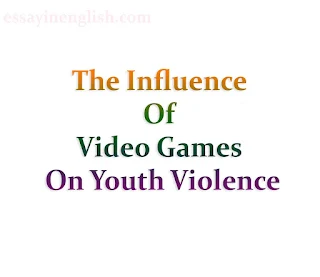This is a argumentative essay on the topic "The influence of video games on youth violence"
Introduction
Video games have become an integral part of modern youth culture, providing entertainment, social interaction, and sometimes even educational benefits. However, concerns have been raised regarding the potential influence of video games on youth violence. This essay explores the complex relationship between video games and youth violence, examining various perspectives, research findings, and potential implications.
Understanding Video Games
Video games encompass a diverse range of genres, from puzzle-solving to action-packed adventures, offering players immersive experiences in virtual worlds. The interactive nature of video games distinguishes them from other forms of media, as players actively engage with the content, making decisions and experiencing consequences based on their actions. This interactivity can have profound effects on players' cognitive, emotional, and behavioral responses.
The Controversy Surrounding Video Games and Violence
The debate over the influence of video games on youth violence has been ongoing for decades, with conflicting viewpoints from researchers, policymakers, and the general public. Proponents of the "media effects" hypothesis argue that exposure to violent video games desensitizes players to real-world violence and fosters aggressive attitudes and behaviors. In contrast, critics challenge these claims, citing insufficient evidence and emphasizing the importance of individual differences, social context, and other factors in shaping behavior.
Research Findings
Numerous studies have attempted to investigate the relationship between video game violence and youth aggression, yielding mixed results. Some research suggests a correlation between playing violent video games and increased aggressive thoughts, feelings, and behaviors among adolescents. For example, a meta-analysis conducted by Anderson and Bushman (2001) found a significant effect size linking exposure to violent video games with heightened aggression.
However, critics argue that many of these studies suffer from methodological limitations, such as reliance on self-report measures, small sample sizes, and lack of longitudinal data. Moreover, some researchers emphasize the importance of considering other factors that may contribute to youth violence, such as family dynamics, peer influence, socioeconomic status, and mental health issues.
Psychological Mechanisms
To understand how video games may influence youth violence, it is essential to explore the underlying psychological mechanisms at play. One theory, known as the General Aggression Model (GAM), proposes that exposure to violent media, including video games, can prime aggressive thoughts and feelings, activate aggressive scripts, and desensitize individuals to violence over time. According to this model, repeated exposure to violent content can shape cognitive schemas and behavioral scripts, leading to a predisposition towards aggression in real-life situations.
However, critics of the GAM argue that it oversimplifies the complex interactions between media consumption and behavior, neglecting individual differences, situational factors, and other contextual variables. Moreover, alternative theories, such as the Catalyst Model, suggest that video games may exacerbate pre-existing aggressive tendencies rather than directly causing aggression.
Cultural and Social Context
The influence of video games on youth violence cannot be fully understood without considering the broader cultural and social context in which gaming occurs. Video games are embedded within a complex network of cultural norms, values, and institutions, shaping and shaped by societal attitudes towards violence, masculinity, and power.
For example, the prevalence of hypermasculine themes and imagery in many popular video games may reinforce traditional gender stereotypes and norms of aggression among young male players. Likewise, the online gaming environment can facilitate socialization processes that normalize and reward aggressive behavior, contributing to a culture of toxicity and hostility within gaming communities.
Regulatory Responses
In response to concerns about the potential impact of violent video games on youth violence, policymakers have implemented various regulatory measures aimed at restricting access to or regulating the content of video games. For instance, some countries have implemented age ratings and content warnings on video game packaging to inform consumers about potentially objectionable content.
However, critics argue that such regulatory efforts may infringe upon freedom of expression and fail to address the underlying social and psychological factors that contribute to youth violence. Moreover, advancements in technology, such as online distribution platforms and user-generated content, pose challenges to traditional forms of regulation, making it difficult to control access to violent content effectively.
Educational and Preventive Interventions
In addition to regulatory approaches, educational and preventive interventions have been proposed as potential strategies for mitigating the negative effects of violent video games on youth violence. For example, media literacy programs aim to empower young people with critical thinking skills and awareness of media influence, enabling them to make informed choices about the media they consume.
Furthermore, interventions targeting parents, educators, and mental health professionals can provide support and guidance for managing children's media use and addressing any potential negative effects. By fostering open communication, setting boundaries, and promoting positive alternatives to screen time, these interventions can help mitigate the influence of violent video games on youth behavior.
Conclusion
The influence of video games on youth violence is a complex and multifaceted issue that defies simple explanations or solutions. While research suggests a correlation between playing violent video games and increased aggression among adolescents, the relationship is far from deterministic, influenced by a myriad of individual, social, and contextual factors.
Moving forward, it is essential to adopt a nuanced and evidence-based approach to understanding and addressing the potential impact of video games on youth violence. By considering the diverse perspectives of researchers, policymakers, industry stakeholders, and the gaming community, we can develop comprehensive strategies that promote responsible gaming practices, foster positive social norms, and support the well-being of young people in an increasingly digital world. Ultimately, by engaging in constructive dialogue and collaboration, we can harness the potential of video games as a force for positive social change while mitigating their potential harms.
Search This Blog
Essay Types
Categories
Most Popular

10 Best Narrative Essay Examples
March 08, 2024

Essay On Environmental Pollution | 100 to 1000 Words
December 13, 2023
Menu Footer Widget
Copyright ©
Essay In English





0 Comments